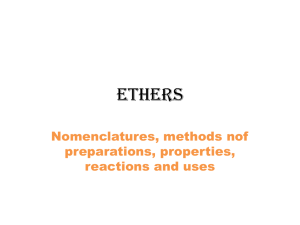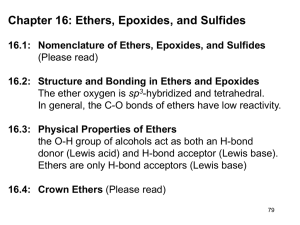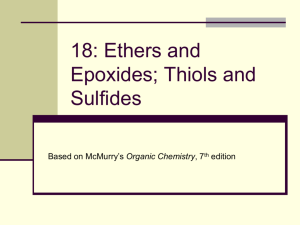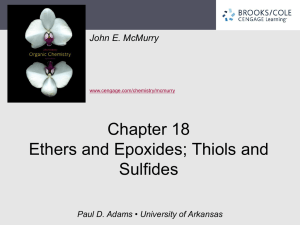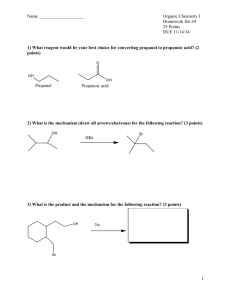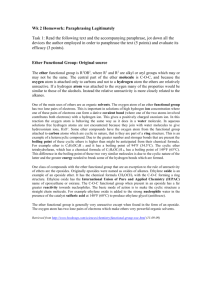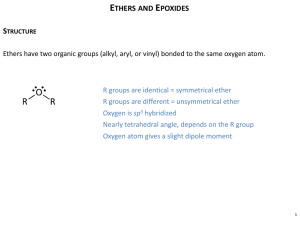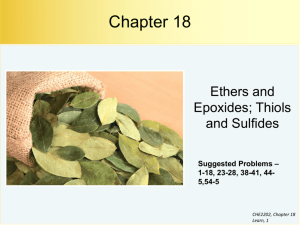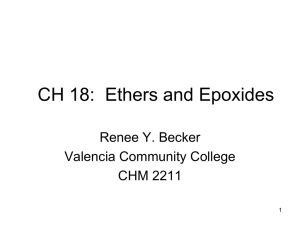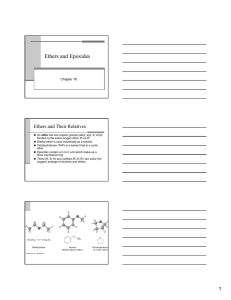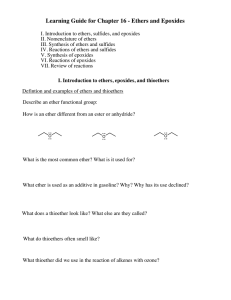Organic Chemistry Lecture Outline Chapter 18: Ethers, Epoxides & Sulfides
advertisement
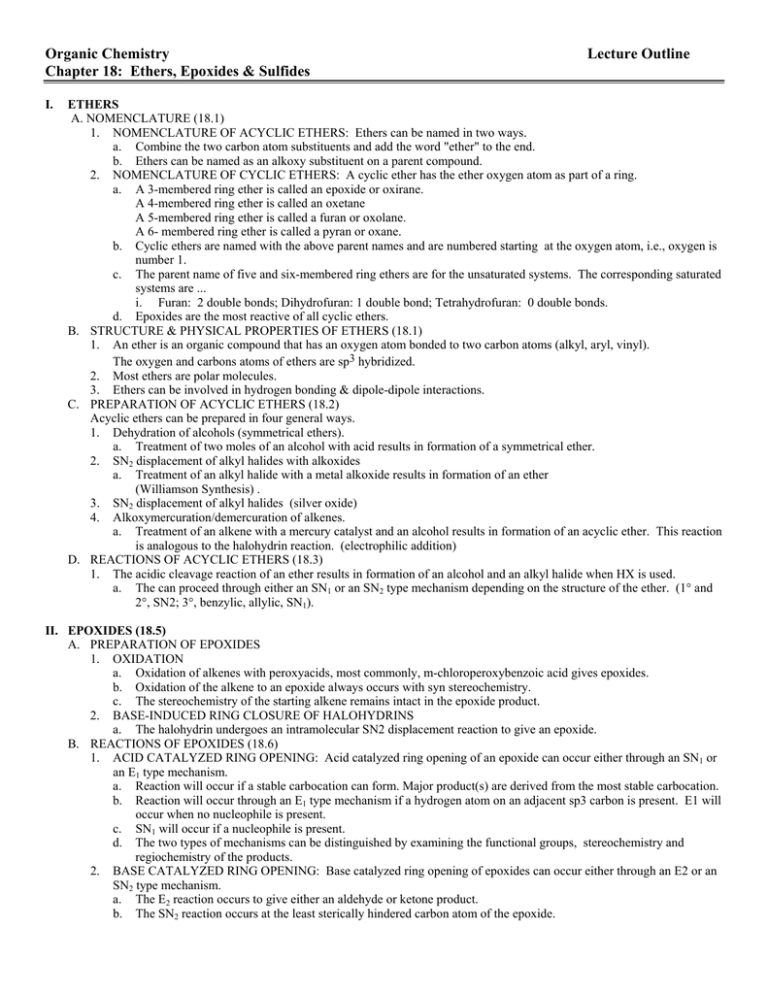
Organic Chemistry Chapter 18: Ethers, Epoxides & Sulfides I. Lecture Outline ETHERS A. NOMENCLATURE (18.1) 1. NOMENCLATURE OF ACYCLIC ETHERS: Ethers can be named in two ways. a. Combine the two carbon atom substituents and add the word "ether" to the end. b. Ethers can be named as an alkoxy substituent on a parent compound. 2. NOMENCLATURE OF CYCLIC ETHERS: A cyclic ether has the ether oxygen atom as part of a ring. a. A 3-membered ring ether is called an epoxide or oxirane. A 4-membered ring ether is called an oxetane A 5-membered ring ether is called a furan or oxolane. A 6- membered ring ether is called a pyran or oxane. b. Cyclic ethers are named with the above parent names and are numbered starting at the oxygen atom, i.e., oxygen is number 1. c. The parent name of five and six-membered ring ethers are for the unsaturated systems. The corresponding saturated systems are ... i. Furan: 2 double bonds; Dihydrofuran: 1 double bond; Tetrahydrofuran: 0 double bonds. d. Epoxides are the most reactive of all cyclic ethers. B. STRUCTURE & PHYSICAL PROPERTIES OF ETHERS (18.1) 1. An ether is an organic compound that has an oxygen atom bonded to two carbon atoms (alkyl, aryl, vinyl). The oxygen and carbons atoms of ethers are sp3 hybridized. 2. Most ethers are polar molecules. 3. Ethers can be involved in hydrogen bonding & dipole-dipole interactions. C. PREPARATION OF ACYCLIC ETHERS (18.2) Acyclic ethers can be prepared in four general ways. 1. Dehydration of alcohols (symmetrical ethers). a. Treatment of two moles of an alcohol with acid results in formation of a symmetrical ether. 2. SN2 displacement of alkyl halides with alkoxides a. Treatment of an alkyl halide with a metal alkoxide results in formation of an ether (Williamson Synthesis) . 3. SN2 displacement of alkyl halides (silver oxide) 4. Alkoxymercuration/demercuration of alkenes. a. Treatment of an alkene with a mercury catalyst and an alcohol results in formation of an acyclic ether. This reaction is analogous to the halohydrin reaction. (electrophilic addition) D. REACTIONS OF ACYCLIC ETHERS (18.3) 1. The acidic cleavage reaction of an ether results in formation of an alcohol and an alkyl halide when HX is used. a. The can proceed through either an SN1 or an SN2 type mechanism depending on the structure of the ether. (1° and 2°, SN2; 3°, benzylic, allylic, SN1). II. EPOXIDES (18.5) A. PREPARATION OF EPOXIDES 1. OXIDATION a. Oxidation of alkenes with peroxyacids, most commonly, m-chloroperoxybenzoic acid gives epoxides. b. Oxidation of the alkene to an epoxide always occurs with syn stereochemistry. c. The stereochemistry of the starting alkene remains intact in the epoxide product. 2. BASE-INDUCED RING CLOSURE OF HALOHYDRINS a. The halohydrin undergoes an intramolecular SN2 displacement reaction to give an epoxide. B. REACTIONS OF EPOXIDES (18.6) 1. ACID CATALYZED RING OPENING: Acid catalyzed ring opening of an epoxide can occur either through an SN1 or an E1 type mechanism. a. Reaction will occur if a stable carbocation can form. Major product(s) are derived from the most stable carbocation. b. Reaction will occur through an E1 type mechanism if a hydrogen atom on an adjacent sp3 carbon is present. E1 will occur when no nucleophile is present. c. SN1 will occur if a nucleophile is present. d. The two types of mechanisms can be distinguished by examining the functional groups, stereochemistry and regiochemistry of the products. 2. BASE CATALYZED RING OPENING: Base catalyzed ring opening of epoxides can occur either through an E2 or an SN2 type mechanism. a. The E2 reaction occurs to give either an aldehyde or ketone product. b. The SN2 reaction occurs at the least sterically hindered carbon atom of the epoxide. Organic Chemistry Chapter 18: Ethers, Epoxides & Sulfides Lecture Outline C. EPOXIDES IN BIOLOGICAL SYSTEMS 1. Epoxide functional groups are found in naturally occurring molecules. 2. Epoxides are key intermediates in the metabolism of many organic compounds. IV. THIOLS A. DEFINITION & PROPERTIES OF THIOLS 1. Thiols are organic compounds which contain an -SH group. 2. Low molecular weight thiols possess very foul odors. 3. Thiols have very weak H-bonds associated with them. 4. Thiols are more acidic than their corresponding alcohols. 5. The conjugate base of a thiol is referred to as an "alkane-thiolate anion" Thiols and thiolates are very strong nucleophiles. B. NOMENCLATURE OF THIOLS 1. Thiols are named by using an "-thiol" suffix with a hydrocarbon parent. 2. When the -SH group is named as a substituent, it is referred to as a "mercapto" group. It may also be referred to as a "sulfhydryl group". IV. SULFIDES A. DEFINITION & NOMENCLATURE 1. Sulfides are organic compounds which contain a sulfur atom bonded to two sp3 carbon atoms. 2. The RS- group is referred to as an "alkylthio" substituent. 3. Sulfides are named like ethers but the ending "sulfide" is used in place of "ether". B. PREPARATION OF SULFIDES 1. Sulfides are prepared from thiols and sodium hydroxide and an alkyl halide. C. REACTIONS OF SULFIDES 1. OXIDATION a. Sulfides can be oxidized with NaIO4 or H2O2 to the corresponding sulfoxide or sulfone. 2. Alkylation a. Sulfides can be alkylated to the corresponding sulfonium salt with alkyl halides.
